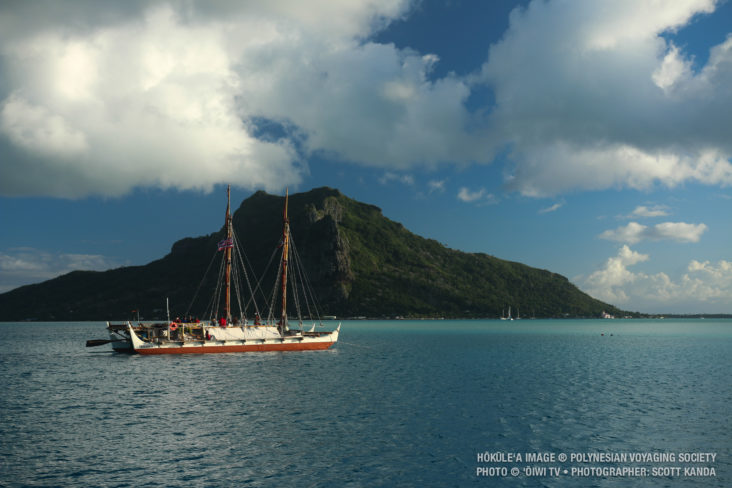I wanted to call attention to the recent return of the Hokule‘a, a double hulled voyaging canoe, to Hawaii after a three year voyage around the world that saw the canoe travel 42,000 miles to 150 ports and 23 countries and territories. It is the first time a Hawaiian canoe has circumnavigated the globe completely under wind power. You can see photos of the return on the Star-Advertiser newspaper site. Apparently about 50,000 people showed up to welcome the canoe.
While the voyage is impressive of itself, the Hokule‘a represents so much more in Hawaii. The canoe was first launched over 40 years ago in 1975 in an attempt to reclaim Hawaiian cultural heritage and knowledge as part of the Hawaiian Renaissance. The Polynesian Voyaging Society sought out the few remaining people who still knew how to navigate in the traditional way without instruments. Only Mau Piailug of the Federated States of Micronesia was willing to teach them.
If you have seen the movie Moana where the title character begs Maui to teach her to navigate, you have gotten a very small hint of what is involved (expand the Read More under Nainoa Thompson’s picture). While later voyages have use Western instruments like compass and sextant and have been supplemented by some technological aids, those first voyages marked the first time in over 500 years that Hawaiian sailors navigated between Hawaii and Tahiti using traditional methods. Later they would use the same techniques to travel to other Pacific Islands and reinvigorate interest in seafaring traditions among other peoples.
The canoe and its voyages have contributed a great deal to the shared cultural consciousness of Hawaii. In 1978, the canoe capsized while still within the archipelago. Crew member Eddie Akau went to get help, paddling his surf board to the island of Lanai. The rest of the crew was rescued, but Eddie was never seen again. To this day, 40 years later, you will drive around and see bumper stickers saying “Eddie Would Go,” as a testament to his selflessness, long established during his career as a lifeguard where he saved over 500 people, often in dangerous surf conditions.
Educators have developed curriculum and programs in connection with the voyages covering a wide range of topics from environmental concerns, geography, tides, navigation, the physics of raising the mast, and genealogy. Star Trek has a Hokule‘a class of starship
I should note, the effort to revive and employ traditional sailing methods wasn’t primarily driven by a desire for authenticity and eschewing modern options. The Hokule‘a was conceived and launched as part of a general effort to recognize and reclaim the validity of Hawaiian music, dance, language, dress, etc after a long period belief that Western/modern ways were superior. The ship answered doubts about the ability of early Polynesians to accurately and consistently navigate between Tahiti and Hawaii using available technology.
As I read about what they have accomplished, it reinforces the long view and sustained effort required to accomplish their goals. Even that first voyage of 40 years ago was preceded by a long period of preparation. It puts the whole process of judging viability by the success or failure achieved increments of 12 months or less in perspective. I think there are lessons here about the power of cultural practices and their ability to fire the imagination.


